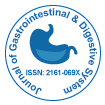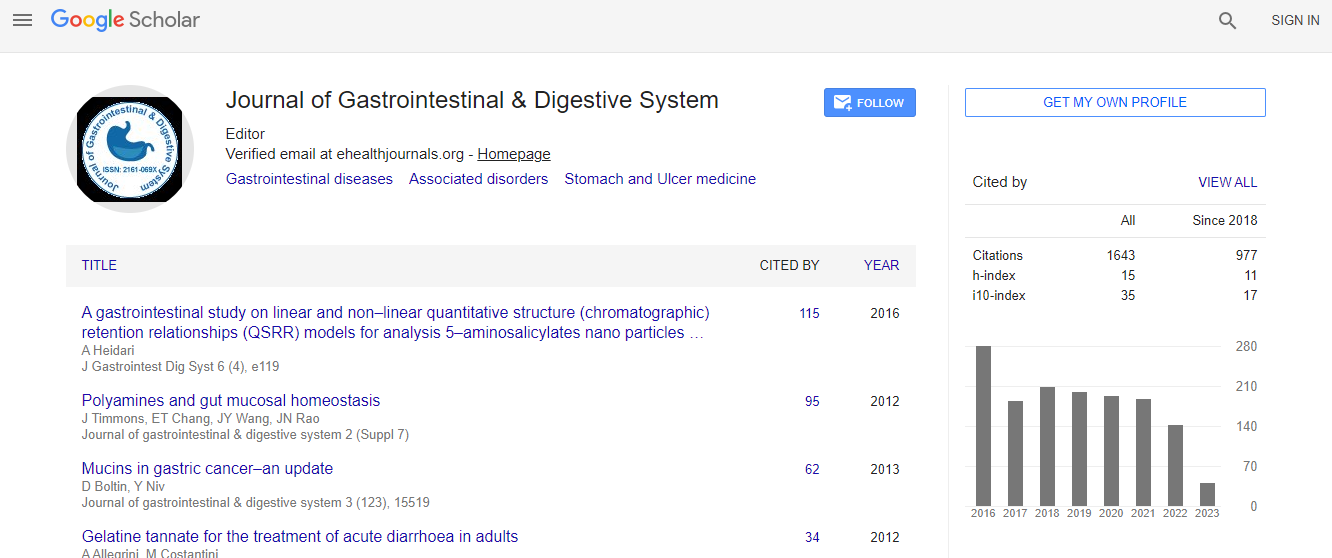Our Group organises 3000+ Global Conferenceseries Events every year across USA, Europe & Asia with support from 1000 more scientific Societies and Publishes 700+ Open Access Journals which contains over 50000 eminent personalities, reputed scientists as editorial board members.
Open Access Journals gaining more Readers and Citations
700 Journals and 15,000,000 Readers Each Journal is getting 25,000+ Readers
Google Scholar citation report
Citations : 2091
Journal of Gastrointestinal & Digestive System received 2091 citations as per Google Scholar report
Journal of Gastrointestinal & Digestive System peer review process verified at publons
Indexed In
- Index Copernicus
- Google Scholar
- Sherpa Romeo
- Open J Gate
- Genamics JournalSeek
- China National Knowledge Infrastructure (CNKI)
- Electronic Journals Library
- RefSeek
- Hamdard University
- EBSCO A-Z
- OCLC- WorldCat
- SWB online catalog
- Virtual Library of Biology (vifabio)
- Publons
- Geneva Foundation for Medical Education and Research
- Euro Pub
- ICMJE
Useful Links
Recommended Journals
Related Subjects
Share This Page
Hepatocarcinoma in Guatemala contrasting global epidemiology
14th Annual Congress on Gastroenterology & Hepatology
Luis Fernando Sandoval Garcia and Manuel Antonio Gatica
Instituto Guatemalteco de Seguridad Social, Guatemala
ScientificTracks Abstracts: J Gastrointest Dig Syst
Abstract
Guatemala has the highest incidence and mortality of Hepatocarcinoma (HCC) in Latin America and the Caribbean in both sexes. This liver neoplasm is the 7th cause of cancer in Central America and the 2nd cause of incidence and cancer mortality in Guatemala. There are many risk factors already identified in the indisputable, first place is cirrhosis, then HBV (chronic and carrier), HCV, alcoholism, NAFLD, etc. Only about 10% of HCCs develop in non-cirrhotic livers. In every day medical practice, we have seen an increase in non-cirrhosis HCC with no other traditional risk factors. It woke up our curiosity and interest to characterize our hepatic cancer. It is an observational, retrospective and analytical study. All HCC attended at IGSS in 2015-2016 were analyzed, researching for epidemiological data, focusing in differences between cirrhotic vs. noncirrhotic patients. Statistical analysis was performed with PSPP 2007. Categorical variables were presented with frequency and percentages and analyzed by chi squared of homogeneity. Normality was tested with Kolmogorov-Smirnov test. Numerical data were evaluated with t-student of independent samples. At relational level a bivariate study was made, then elevated to multivariate level. Total of 53 HCC cases were found, 15 cirrhotic and 38 non-cirrhotic (71.69%). Comparing both groups, there is no statistical difference between age, BMI, sex, family history of cancer, alcoholism, tobacco, diabetes mellitus, obesity, HBV, HCV, AFP, mass diameter, nor treatment (surgery, TACE, radiofrequency and sorafenib). There is difference in jaundice, ascites and encephalopathy, possibly due the same cirrhosis. It should be emphasized the importance of the high number of HCC in apparently healthy livers, contrasting global epidemiology. Staring with this new revealing knowledge we must analyze our medical approach to diagnose and manage HCC in Guatemala and look for our non-traditional risk factors.Biography
Luis Fernando Sandoval Garcia has graduated in General Medicine from Universidad de San Carlos de Guatemala with a Master’s degree and Chief of Residents in Internal Medicine at IGSS. He works as an Internal Medicine Attending Physician in the same institute and as Professor in Universidad Francisco Marroquin. Locally he has published researches about gastric cancer, esophageal varices, cirrhosis and HCC. He has showed the first epidemiological formal evidence of the non-cirrhotic HCC at IGSS, Guatemala.
E-mail: lufesandoval@ufm.edu

 Spanish
Spanish  Chinese
Chinese  Russian
Russian  German
German  French
French  Japanese
Japanese  Portuguese
Portuguese  Hindi
Hindi 
